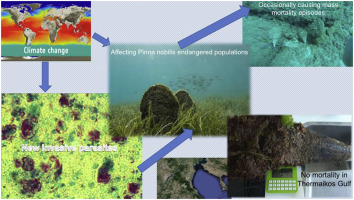当前位置:
X-MOL 学术
›
Mar. Environ. Res.
›
论文详情
Our official English website, www.x-mol.net, welcomes your feedback! (Note: you will need to create a separate account there.)
First detection of the invasive Haplosporidian and Mycobacteria parasites hosting the endangered bivalve Pinna nobilis in Thermaikos Gulf, North Greece.
Marine Environmental Research ( IF 3.3 ) Pub Date : 2020-01-23 , DOI: 10.1016/j.marenvres.2020.104889 Athanasios Lattos 1 , Ioannis A Giantsis 2 , Dimitrios Karagiannis 3 , Basile Michaelidis 1
Marine Environmental Research ( IF 3.3 ) Pub Date : 2020-01-23 , DOI: 10.1016/j.marenvres.2020.104889 Athanasios Lattos 1 , Ioannis A Giantsis 2 , Dimitrios Karagiannis 3 , Basile Michaelidis 1
Affiliation

|
Mycobacterium sp. and Haplosporidium pinnae constitute invasive parasite species of bivalves, reported for the first time in the present study in the Aegean Sea and Thermaikos Gulf, respectively. During the last years, the endangered fan mussel (Pinna nobilis) experienced several mortality events in the Mediterranean Sea that caused deaths to 90% or more of their populations and have been attributed to infections by these pathogens. In Greece, two mass mortality events have been recently reported, namely in the Gulf of Kalloni and in Limnos island. In the present study we investigated the presence of both pathogens in P. nobilis from these marine areas as well as from Thermaikos Gulf using both histopathological microscopy and molecular markers. The detected parasite DNA was further quantified in the three populations utilizing a real time qPCR. Histopathological results indicated the presence of a Mycobacterium species alongside with the existence of the Haplosporidian parasite, which was identified in all mortality events in the Mediterranean Sea. The parasite was present in different phases mostly on the digestive gland epithelium. Phylogenetic analysis confirmed the taxonomy of the Haplosporidian parasite as the recently described Haplosporidium pinnae, whereas it failed to identify the Mycobacteria parasite at species level. While Mycobacterium sp. was detected in all examined specimens, H. pinnae was not detected in all diseased fan mussels. Interestingly, monitoring of P. nobilis population from Thermaikos Gulf, an estuary of extremely high importance for bivalve production, revealed the presence of both pathogens in a few specimens in higher quantity but with no symptoms of the disease. Besides, all the specimens from Thermaikos Gulf had inflammatory responses similarly to moribund specimens from mortality events.
中文翻译:

首次在希腊北部Thermaikos海湾发现具有濒临灭绝的双壳类Pinna nobilis的侵入性单倍体和分枝杆菌寄生虫。
分枝杆菌 在本研究中首次在爱琴海和Thermaikos海湾中首次报道了梭梭和羽状单孢菌构成双壳类的侵入性寄生虫物种。在过去的几年中,濒临灭绝的扇贝(Pinna nobilis)在地中海经历了几次死亡事件,这些死亡事件导致90%或以上的人口死亡,并归因于这些病原体的感染。在希腊,最近报告了两次大规模死亡事件,即卡洛尼湾和利姆诺斯岛。在本研究中,我们使用组织病理学显微镜和分子标记物研究了来自这些海洋地区以及来自Thermaikos Gulf的诺伊体育中两种病原体的存在。使用实时定量PCR在三个种群中进一步定量检测到的寄生虫DNA。组织病理学结果表明存在分枝杆菌菌种,同时存在单倍体寄生虫,这在地中海的所有死亡事件中均已发现。寄生虫主要存在于消化腺上皮细胞的不同阶段。系统发育分析证实了单倍体寄生虫的分类学,如最近描述的羽状单孢菌,而未能在物种水平上鉴定分枝杆菌寄生虫。而分枝杆菌 在所有检查过的标本中均检出了扁桃体,而在所有患病的扇贝贻贝中均未检出扁豆。有趣的是,监测来自Thermaikos海湾的No.bilis种群,这对双壳类动物的生产极为重要,揭示了一些标本中两种病原体的含量较高,但没有这种疾病的症状。此外,所有Thermaikos Gulf的标本都具有与死亡致死的标本相似的炎症反应。
更新日期:2020-01-23
中文翻译:

首次在希腊北部Thermaikos海湾发现具有濒临灭绝的双壳类Pinna nobilis的侵入性单倍体和分枝杆菌寄生虫。
分枝杆菌 在本研究中首次在爱琴海和Thermaikos海湾中首次报道了梭梭和羽状单孢菌构成双壳类的侵入性寄生虫物种。在过去的几年中,濒临灭绝的扇贝(Pinna nobilis)在地中海经历了几次死亡事件,这些死亡事件导致90%或以上的人口死亡,并归因于这些病原体的感染。在希腊,最近报告了两次大规模死亡事件,即卡洛尼湾和利姆诺斯岛。在本研究中,我们使用组织病理学显微镜和分子标记物研究了来自这些海洋地区以及来自Thermaikos Gulf的诺伊体育中两种病原体的存在。使用实时定量PCR在三个种群中进一步定量检测到的寄生虫DNA。组织病理学结果表明存在分枝杆菌菌种,同时存在单倍体寄生虫,这在地中海的所有死亡事件中均已发现。寄生虫主要存在于消化腺上皮细胞的不同阶段。系统发育分析证实了单倍体寄生虫的分类学,如最近描述的羽状单孢菌,而未能在物种水平上鉴定分枝杆菌寄生虫。而分枝杆菌 在所有检查过的标本中均检出了扁桃体,而在所有患病的扇贝贻贝中均未检出扁豆。有趣的是,监测来自Thermaikos海湾的No.bilis种群,这对双壳类动物的生产极为重要,揭示了一些标本中两种病原体的含量较高,但没有这种疾病的症状。此外,所有Thermaikos Gulf的标本都具有与死亡致死的标本相似的炎症反应。


























 京公网安备 11010802027423号
京公网安备 11010802027423号